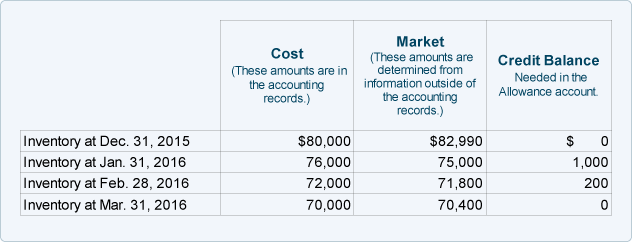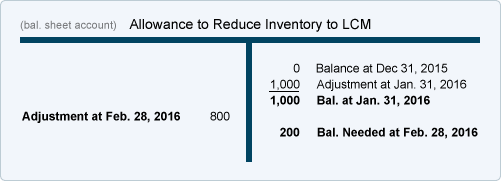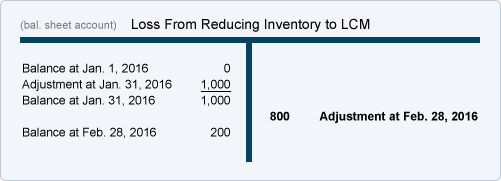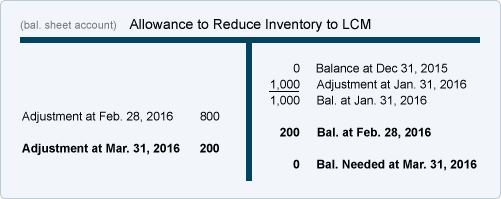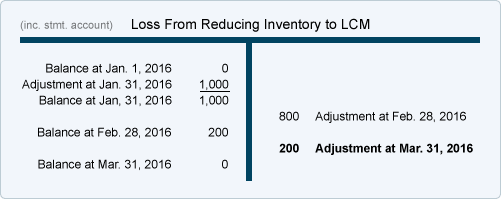Accounting For Lower of Cost or Market
For companies reporting inventory under the lower of cost or market rule, it is common to use the contra assetinventory account Allowance to Reduce Inventory to LCM. This balance sheet account is used to report the amount that the inventory's market amount is below the inventory's cost amount. In other words, the combination of the Inventory account balance and the Allowance account balance will equal the lower of cost or market. The result is the account Allowance to Reduce Inventory to LCM will have a credit balance for the amount that the market value of the inventory is less than the cost shown in the Inventory account. If the market value of the inventory is greater than cost, a zero balance appears in the account Allowance to Reduce Inventory to LCM. (There cannot be a debit balance in Allowance account because of the cost principle and the revenue recognition principle.)
Because of the rules of double-entry accounting, whenever the balance in the Allowance account is adjusted, a second account is needed. The second account will be an income statement account, such as Loss from Reducing Inventory to LCM.
We'll use the following information to illustrate accounting for lower of cost or market (LCM):
At December 31, 2014 the company's balance sheet will report Inventory of $80,000 since this amount is the lower of cost ($80,000) or market ($82,900). The general ledger accounts show these balances:
No adjustment was needed at December 31 because 1) market was greater than the cost, and 2) the balance in the Allowance account was previously at $-0-.
At January 31, 2015 the company's balance sheet needs to report Inventory of $75,000 since this amount is the lower of cost or market on that date. The company's income statement for the month of January 2015 should report a Loss of $1,000, since the decline below market occurred in January and the market is expected to remain lower than cost. If the company uses the Allowance account for valuation, the pertinent general ledger accounts will have the following adjustment:
In general journal format, the adjusting entry at January 31, 2015 is:
This entry is similar to other adjusting entries (see Explanation of Adjusting Entries) in that it involves a balance sheet account (Allowance to Reduce Inventory to LCM) and an income statement account (Loss from Reducing Inventory to LCM).
We used the T-accounts to make certain we got the correct amounts into the balance sheet account. We asked ourself: What should the balance be in the account Allowance to Reduce Inv to LCM at January 31, 2015? The answer is that the balance at January 31 should be a credit balance of $1,000 because the market value at that date is $1,000 below the cost being reported in the Inventory account. The second question we asked was: What is the present balance in the Allowance account? The answer was that prior to an adjustment on January 31, the balance was $-0-. So how do we get the Allowance account from a balance of $-0- to the $1,000 credit balance that is needed as of January 31? The solution is to enter a credit of $1,000 in the Allowance account. (That of course means a debit of $1,000 will be entered into the Loss account.) After we record that January 31 adjusting entry the balance sheet will report the ending account balances as follows:
On February 28, 2015 the balance sheet needs to report the lower of cost or market of $71,800. (Earlier, we assumed that on Feb. 28 the cost was $72,000 and the market was $71,800.) Throughout February there were transactions in the Inventory account that resulted in the ending cost balance on February 28 of $72,000. In order for the balance sheet to report the correct lower of cost or market of $71,800 as shown next, the balance in the Allowance account at February 28 will need to be a credit balance of $200:
The journal entry needed at February 28 can be determined by using T-accounts:
In general journal format, the adjusting entry at February 28, 2015 is:
This journal entry shows a recovery of $800 of the $1,000 loss recorded in January.
On March 31, 2015 the balance sheet needs to report the lower of cost or market of $70,000. (Recall that our assumptions were cost of $70,000 and market of $70,400.) Throughout March there were transactions in the Inventory account and our assumptions meant that the ending balance in Inventory at March 31 was $70,000. In order for the balance sheet to report the correct LCM of $70,000, the balance in the Allowance account at March 31 will need to be a balance of $0.
Again, the journal entry needed at March 31 can be determined by using T-accounts:
In general journal format, the adjusting entry at March 31, 2015 is:
Our March 31 journal entry shows the remaining $200 recovery from the $1,000 loss previously recorded in January 2015. (Note: We did not report the recovery as a "gain" of $200 during March nor did we report a "gain" of $800 in February. We avoided the word "gain" since the company did not increase its inventory carrying amount above its cost; it merely restored the inventory amount back to its cost.)
» Tin mới nhất:
- Những Website Check Lỗi Ngữ Pháp Tiếng Anh Chất Lượng (18/05/2024)
- The writing process and assessment (18/05/2024)
- Những kinh nghiệm làm đồ án dành cho sinh viên kiến trúc (18/05/2024)
- Vai trò của các công cụ khuyến mãi đối với hành vi tiêu dùng (18/05/2024)
- Quyết định đầu tư chứng khoán và các mô hình nghiên cứu (18/05/2024)
» Các tin khác:
- Applying Lower of Cost or Market To Inventory (18/10/2016)
- Lý do chọn mạng xã hội FACEBOOK của sinh viên (18/10/2016)
- Đánh giá nhân viên từ xa (18/10/2016)
- Những tiêu chí xây dựng chương trình đánh giá nhân viên (18/10/2016)
- 4 BỨC THƯ QUAN TRỌNG GỬI TỚI NHÀ TUYỂN DỤNG (18/10/2016)
- Kỹ thuật làm giá trong đầu tư chứng khoán (17/10/2016)
- Nhu cầu quản trị nhân lực trong các chiến lược (17/10/2016)
- Vai trò của quản trị nguồn nhân lực trong thực thi chiến lược (17/10/2016)
- Introduction to Lean production (17/10/2016)
- Introduction to Logistic (17/10/2016)







